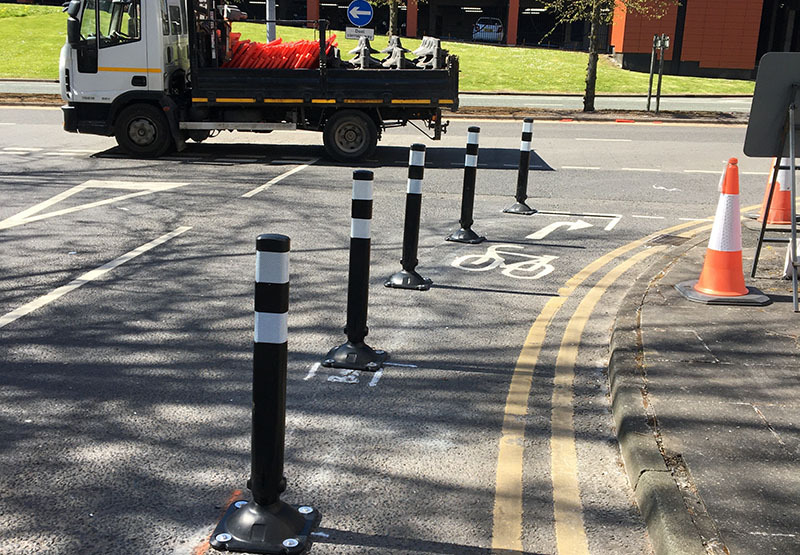“They are not safe. They are anything but for safety,” said a woman who added vehicles in the two-block section sometimes drive in the middle of Springbrook to avoid the bollards.
Oh, so drivers behind of the wheel of an automobile are the danger. Why remove the bike lanes rather than the car lanes?
I heard that Etobicoke’s NIMBYs are insane, but this is a new level of stupidity from Richmond Hill.
Speeding cars on icy days are what makes the road unsafe. Not the bike lanes or the cyclists.
Vertical paint/plastic bollards don’t work terribly well, but concrete barriers, speed bumps, and elevated crosswalks do. More expensive per kilometer, but significantly safer and also has a calming effect for pedestrian safety, too.
and even then it’s not like it’s actually expensive, literally just putting down a kerb and pouring some asphalt to create what’s effectively a sidewalk gives you perfectly fine bike infrastructure, and that’s hilariously cheap compared to most car infrastructure.
It’s usually not an option to add a curb since that creates issues with drainage, and that type of work would only reasonably happen during a complete road reconstruction (where even the road bed requires replacing). However, there is the Toronto solution of dropping concrete barriers with openings on the bottom to allow storm water runoff to pass while providing a more concrete (heh) barrier for cyclists
Oakland is transforming our hollowed-out downtown installing barriers for better bike lanes. Sacrificing one lane of traffic on each side, but it’s not like many people come to work downtown anymore.
Yeah not from the area. The only reason I’ve ever wanted bike protection lanes removed is to dodge other vehicles. I’ve never had an issue with bikers in the biker lanes…
It shouldnt be an issue either way if you’re an attentive driver. But there are too many people driving who aren’t attentive. So /me shrugs. A cars a car. A life is more important
from Florida. other than to school and back I don’t drive much. I think I’ve seen 2 cyclists on the little bike lane in about a year of driving
Florida drivers would scare me off a bike too
Florida scare me too
Oh, they are called Bollards.
Hate em, they are put in the middle of the bike lane making it literally unusable as a bike lane, so bikes have to swerve into the lane and out, or just stay on the road. What a useful bike lane.
I don’t understand. They work in large cities, but can’t work on a tiny street in Richmond Hill?
The ones in question are placed only at turns, which prevent cars from right hooking cyclists or turning from the bike lane or parking in the bike lane.
This would, in no way, prevent cyclists from cycling. I don’t even know why you’d need to “swerve into the lane and out” when the bike lane is actually quite clear because of them. If the bollards were replaced with a curb (like in an actually separated bike lane), would you still need to swerve in and out of the lane??
Why did anyone think bollards are a good way of adding biking infrastructure? I don’t like them when I ride by bike or drive my car. Who likes them??
Keep in mind that we’re talking Richmond Hill in Ontario… an area where cycling infrastructure isn’t easy to get.
In this case, say you’ve got the following options, let me know what you’d choose:
a) No cycling infrastructure at all. No sharrows. No bike route sign. No bollards. No painted gutters. Cars will park where they like, turn into the way of cyclists causing “right hook” accidents on a regular basis.
b) A “bike lane” that gets filled with parked cars, forcing cyclists into the car lane (causing an increase in crashes and cycling injuries/fatalities). There’s a bike route sign, but intersections are a free-for-all with frequent right-hook crashes.
c) A mess of painted bike gutters, signs, and sharrows. But turns are protected by plastic bollards, so drivers don’t use the bike lane as a turning lane.
Unfortunately, you won’t have the option for separated, dedicated bike lanes or multiuse paths (especially not on this small, residential street). Not only due to the lack of space, but because NIMBYs will not allow it.
There is no “best” solution when given crappy options. But if I had the option to put inexpensive, plastic bollards on right turns so that drivers fear getting their car scratched up (with a side-effect that they aren’t running over cyclists during right turns), then I’d go with that until a better solution comes up.
Also, you guys are aware that bollards (both plastic, but also metal and concrete) are used in some pretty major bike and pedestrian-friendly cities. Amsterdam has them protecting nearly every corner. San Francisco has them on both sides of their bike lanes, so cars can’t enter them. Even in the bike-hating UK, you’ll see them protecting right turns for cyclists:

So are they all that’s needed for cycling infrastructure? No, of course not. But having them is better than not. At the very least, they keep people from parking in bike lanes at intersections.





